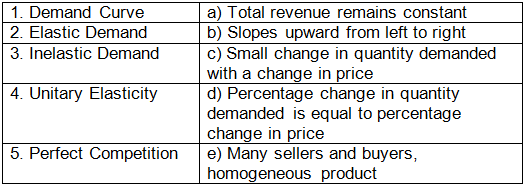Worksheet: Introduction to Microeconomics- 1 | Economics Class 11 - Commerce PDF Download
| Table of contents |

|
| Multiple Choice Questions |

|
| Match the Following |

|
| True or False |

|
| Very Short Answers |

|
| Short Answers |

|
| Long Answers |

|
Multiple Choice Questions
Q1: What is the primary focus of microeconomics?
(a) Individual households and firms
(b) National economy
(c) Macroeconomic factors
(d) Global trade
Q2: Which of the following is a determinant of demand?
(a) Price of the product
(b) Population
(c) Government policies
(d) All of the above
Q3: In microeconomics, what does the term 'elasticity' refer to?
(a) The responsiveness of quantity demanded to a change in price
(b) The total revenue of a firm
(c) Market equilibrium
(d) Consumer surplus
Q4: What is the law of diminishing marginal utility?
(a) As a consumer consumes more units of a good, the additional satisfaction decreases
(b) The more a good is produced, the lower its price becomes
(c) Demand and supply always reach equilibrium
(d) Consumers always make rational decisions
Q5: What does a production possibilities curve illustrate?
(a) The maximum combination of goods and services that a society can produce
(b) The production capacity of a single firm
(c) Consumer preferences
(d) Government regulations on production
Match the Following
Q1: Match the Following

True or False
Q1: Microeconomics studies individual economic units like households and firms.
Q2: Elastic demand means that quantity demanded does not change with a change in price.
Q3: In a perfectly competitive market, there are many sellers and differentiated products.
Q4: Price ceiling is a government-imposed maximum price on a good or service.
Q5: Scarcity refers to the situation where human wants exceed the resources available to fulfill those wants.
Very Short Answers
Q1: Define 'Market Demand'.
Q2: What is a 'Price Floor'?
Q3: Explain 'Consumer Surplus'.
Q4: Define 'Marginal Cost'.
Q5: What is 'Elasticity of Demand'?
Short Answers
Q1: Explain the concept of 'Law of Demand'.
Q2: Discuss the factors affecting 'Elasticity of Supply'.
Q3: Describe 'Monopoly' as a market structure.
Q4: Explain the term 'Consumer Equilibrium'.
Q5: Discuss the impact of 'Price Elasticity of Demand' on tax incidence.
Long Answers
Q1: Explain the concept of 'Production Possibility Frontier (PPF)' and its significance in economics.
Q2: Discuss the impact of government policies on market equilibrium using suitable examples.
Q3: Explain the concept of 'Elasticity of Demand' and its types with examples.
Q4: Discuss the role of 'Utility' in consumer decision-making and its relationship with the law of diminishing marginal utility.
Q5: Explain the concept of 'Market Failure' and discuss its types with examples.
You can access the solutions to this worksheet here.
|
59 videos|290 docs|51 tests
|
FAQs on Worksheet: Introduction to Microeconomics- 1 - Economics Class 11 - Commerce
| 1. What is microeconomics? |  |
| 2. What are some key concepts in microeconomics? |  |
| 3. How does microeconomics differ from macroeconomics? |  |
| 4. Why is microeconomics important? |  |
| 5. How can I apply microeconomic principles in real life? |  |















